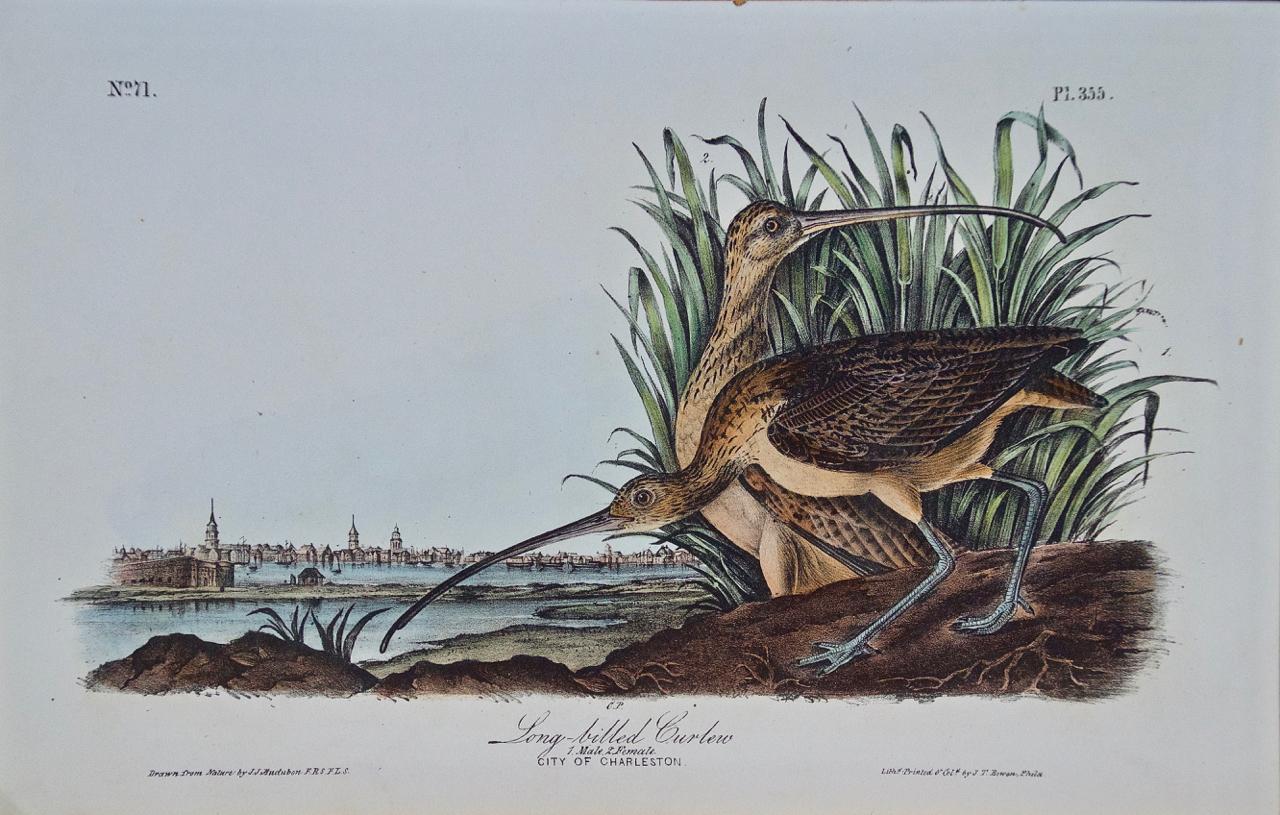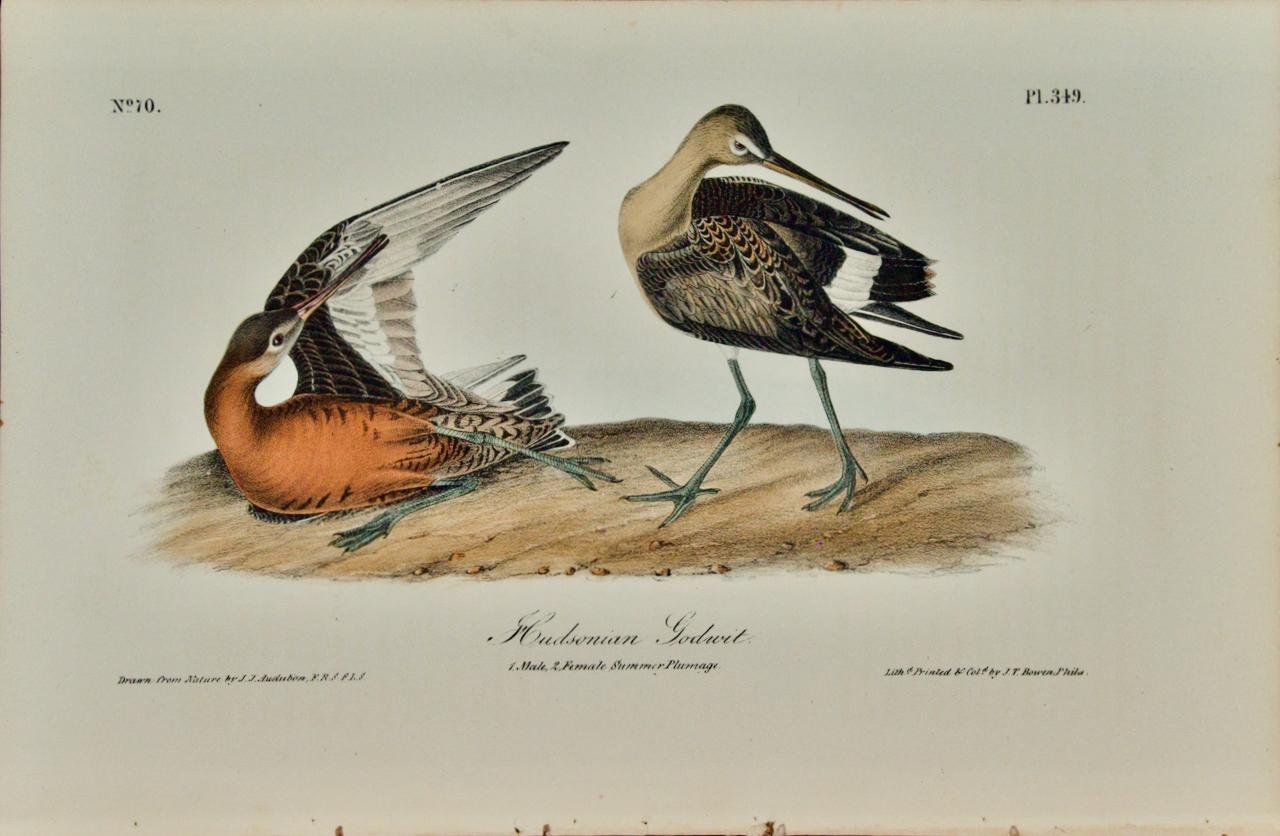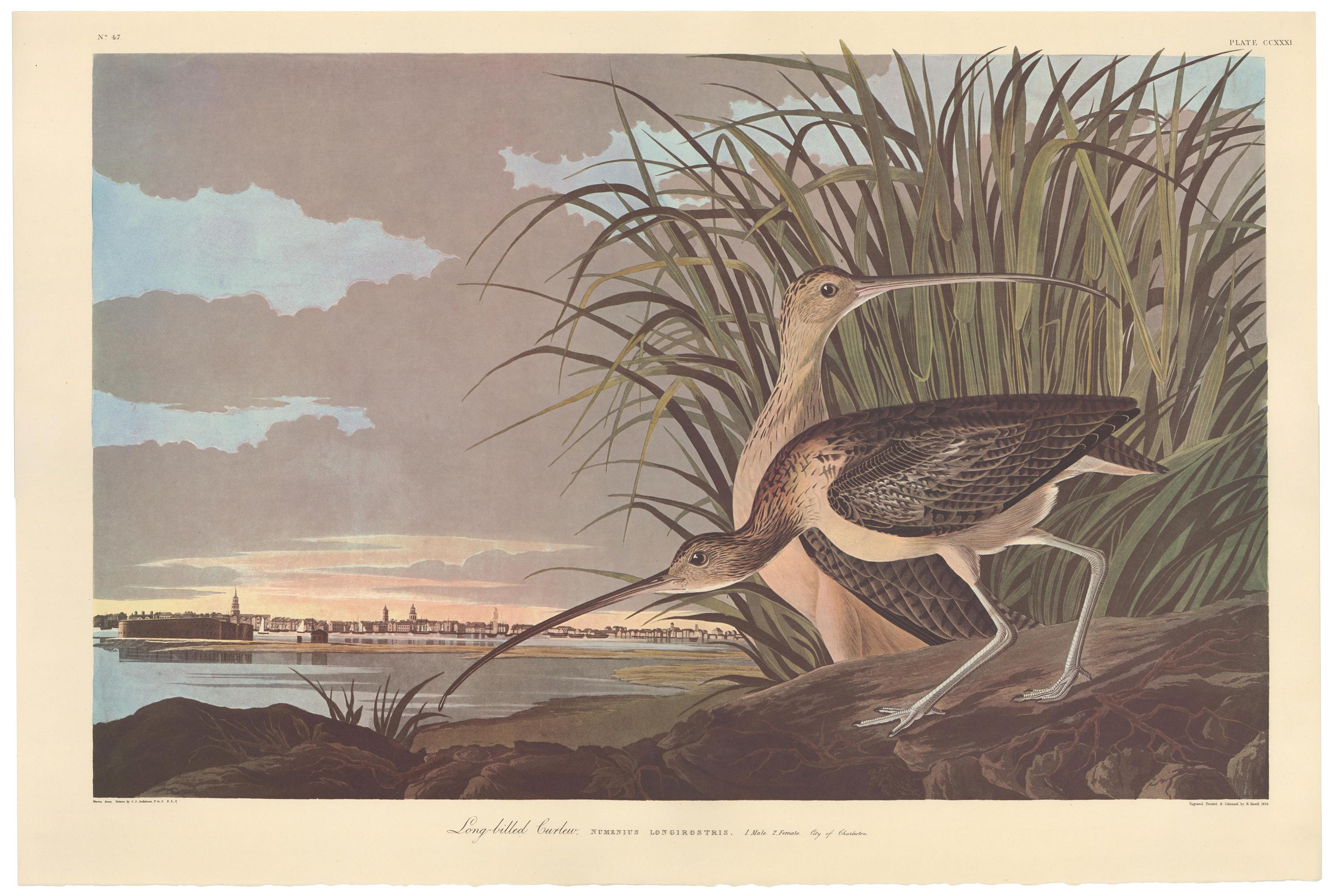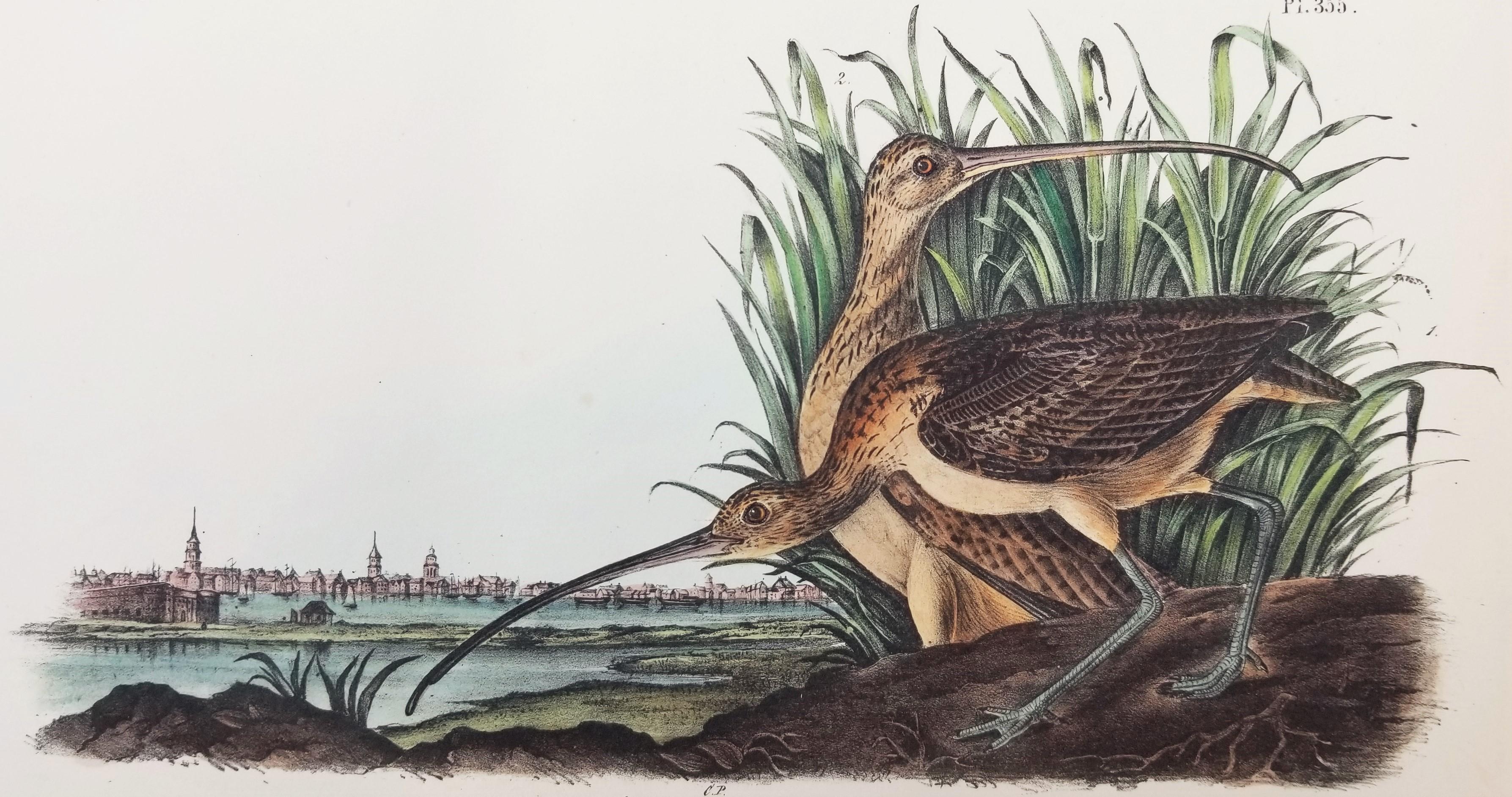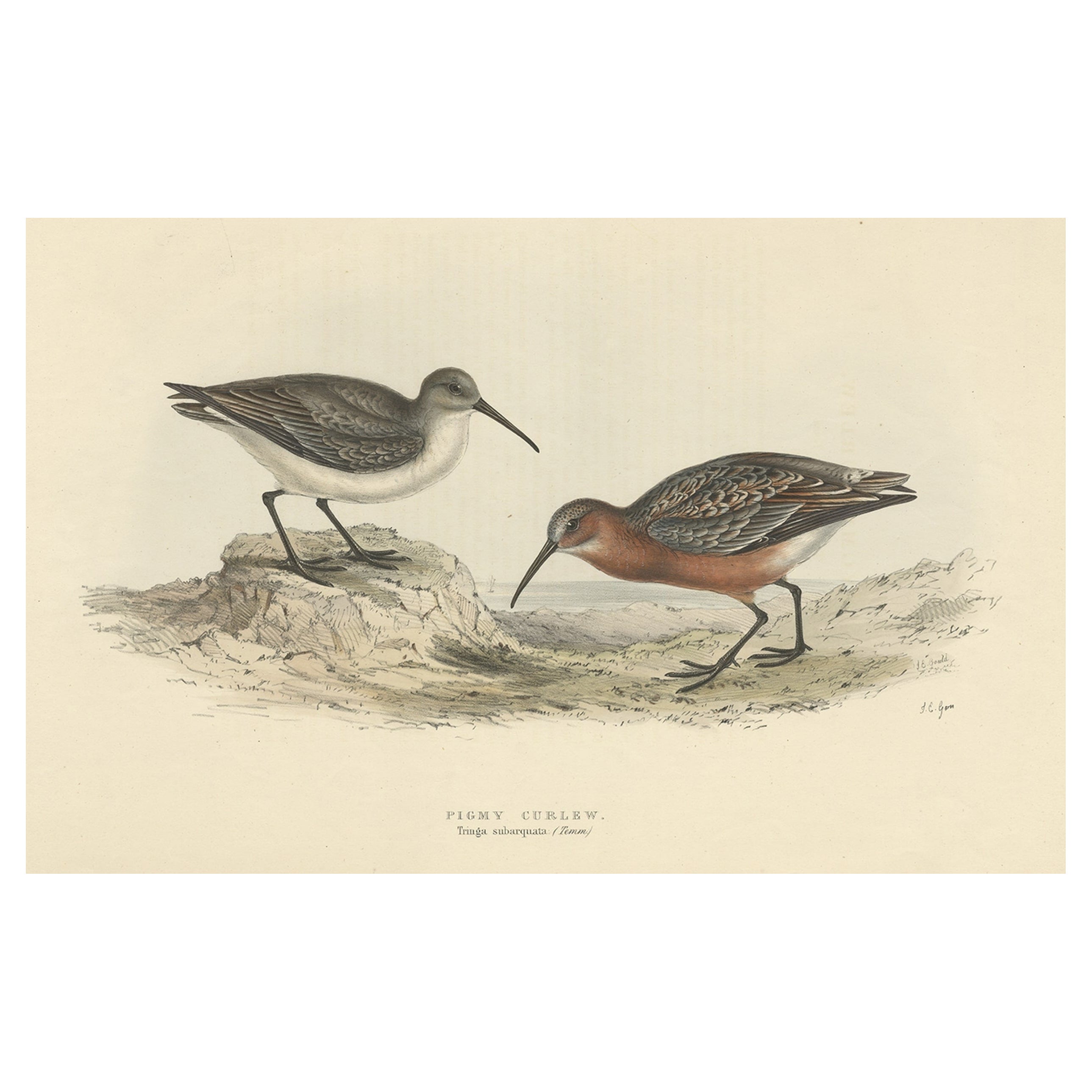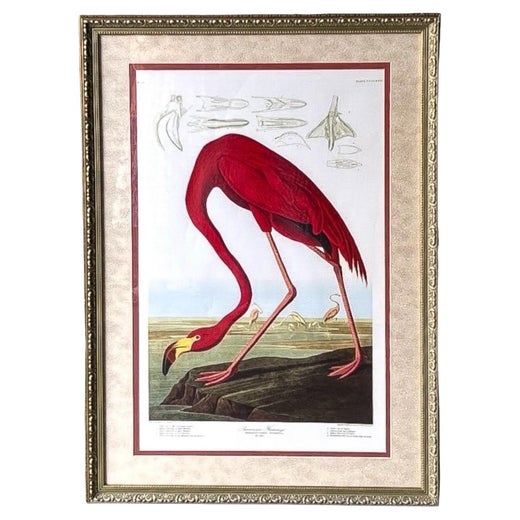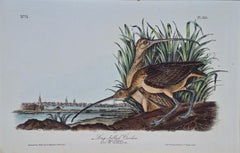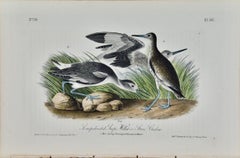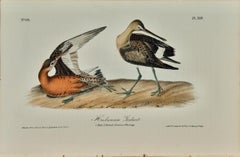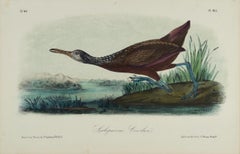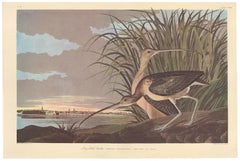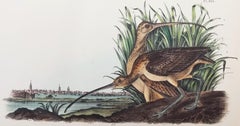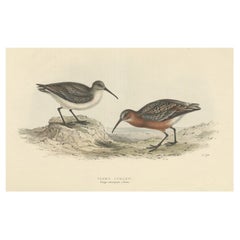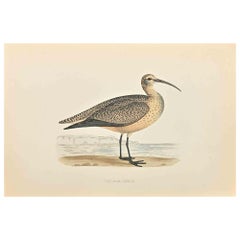Items Similar to "Esquimaux Curlew": A Framed Original Audubon Hand-colored Folio Engraving
Want more images or videos?
Request additional images or videos from the seller
1 of 12
John James Audubon"Esquimaux Curlew": A Framed Original Audubon Hand-colored Folio Engraving1834
1834
$3,775
£2,860.28
€3,281.94
CA$5,312.03
A$5,839.39
CHF 3,068.91
MX$70,911.43
NOK 38,283.93
SEK 36,271.33
DKK 24,493.97
About the Item
This is an original hand-colored folio edition John James Audubon engraving entitled "Esquimaux Curlew", Folio, Pl. CCVIII", No. 42, Plate 208, from Audubon's "Birds of America". It was engraved, printed and colored in London by Robert Havell, Jr. in 1834. It depicts a male and a female Esquimaux Curlew birds on land. The male stands on a mound and the female lies on the ground. The esquimaux curlew bird was once abundant in the United States, but it is currently presumed extinct, as it was last seen in 1962.
This original folio edition hand-colored Audubon bird engraving is presented in a medium brown-colored wood frame with a charcoal gray-colored mat. It is glazed with UV conservation glass. All of the framing and mounting materials are archival. The frame measures 23.25" high by 28.38 wide by 0.75" deep". The sheet appears to have been trimmed. There is a small spot in the upper right and a few tiny barely perceptible spots elsewhere. The print is otherwise in very good condition.
Audubon had rarely seen an Esquimaux Curlew in the wild. Here is an excerpt from his book in his own words: "How this species manages to cross the whole extent of the United States without being seen after leaving Massachusetts, is to me very wonderful. On one occasion only have I ever had a glimpse of it. I was in company with my learned and generous friend John Bachman of Charleston, on one of the islands on the coast of South Carolina, whither we had gone with the view of watching the Long-billed Curlews (Numenius longirostris). It was at the dawn of a fine day, when a dense flock of the northern Curlews passed to the southward, near enough to enable us to ascertain the species, but so swiftly, that in a few minutes they were quite out of sight.
On the 29th of July, 1833, during a thick fog, the Esquimaux Curlews made their first appearance in Labrador, near the harbour of Brag d'Or. They evidently came from the north, and arrived in such dense flocks as to remind me of the Passenger Pigeons. The birds at length came, flock after flock, passed close round our vessel, and directed their course toward the sterile mountainous tracts in the neighbourhood."
John James Audubon (1785-1851) was a naturalist and artist. He was initially unsuccessful financially prior to the publication of his famous work “The Birds of America”, spending time in debtor’s prison, once stabbing a disgruntled investor in self-defense. However, his obsession with birds and art motivated him to persist in his goal of documenting every bird in America via his watercolor paintings and publishing his works for all to enjoy. Audubon's first illustrations were published in a large elephant folio size, engraved in London by Robert Have, Jr.. Due to their expense they were purchased in rather small numbers by the wealthy. To reach a larger audience, Audubon, with the help of his sons and J. T. Bowen, published a smaller octavo sized lithograph version, which were much more affordable.
With the success of his bird projects, Audubon then turned his attention to four-legged animals. He explored the Missouri River in 1843 sketching the four-legged animals he encountered in their natural setting. His expedition covered some of the same regions recently explored by Lewis and Clark, traveling from present day Alaska to Mexico. Audubon realized that this was an opportunity to document these animals in the still relatively pristine American wilderness, before man encroached on their environment.
Between 1845 and 1848, Audubon and his sons John Woodhouse Audubon and Victor Gifford Audubon produced a set of elephant folio sized lithographs that were primarily engraved and hand colored by J. T. Bowen in Philadelphia. The publication, which included text descriptions of the animals was published 3 years before Audubon died. As with the birds, this was followed by a three-volume set of 155 octavo-sized plates entitled “The Quadrupeds of North America” completed and published by Audubon’s sons, John, Jr. and Victor.
Audubon prints continue to be popular and a wise investment. The double elephant folio set “The Birds of America” have sold at auction for as much as $8.8 million, and individual plates may sell for six figures. The beautiful octavo sized plates are not as expensive, but becoming more sought after, as the folio bird plates become unattainable to all but the very wealthy.
Robert Havell Jr. (1793-1878) was the main engraver for Audubon's folio Birds of America publication. His aquatint engravings of most of the plates (except for the first ten) is considered a significant artistic achievement and was essential to the success of Audubon's Birds of America. Havell and Audubon became close friends and associates. In 1839 Havell went to America at the invitation of Audubon, first residing in Brooklyn. He settled in Ossining on the Hudson River and later moved to Tarrytown, New York, where he remained for the rest of his life. After the publication of Birds of America, Havell continued to create engravings, but became more known for his landscape and countryside paintings of the Hudson River valley. He travelled frequently in a homemade horse-drawn trailer, sketching and taking notes and translating his sketches into larger oils. He is considered an influential contributor of the Hudson River School of American painters. Havell died in 1878 and is buried in Sleepy Hollow Cemetery in Sleepy Hollow, located in the town of Mount Pleasant in Westchester County, New York, on the east bank of the Hudson River, with the village of Tarrytown to the south.
- Creator:John James Audubon (1785-1851, American, French)
- Creation Year:1834
- Dimensions:Height: 23.25 in (59.06 cm)Width: 28.38 in (72.09 cm)Depth: 0.75 in (1.91 cm)
- Medium:
- Movement & Style:
- Period:
- Condition:
- Gallery Location:Alamo, CA
- Reference Number:Seller: # 1971stDibs: LU117329845302
John James Audubon
John James Audubon (April 26, 1785, Les Cayes, Saint-Domingue (later Haiti) – January 27, 1851 (aged 65) Manhattan, New York, U.S.), born Jean-Jacques Audubon, was an American ornithologist, naturalist, and painter. He was notable for his expansive studies to document all types of American birds and for his detailed illustrations that depicted the birds in their natural habitats. His major work, a color-plate book entitled The Birds of America (1827–1839), is considered one of the finest ornithological works ever completed. Audubon identified 25 new species.
About the Seller
5.0
Gold Seller
Premium sellers maintaining a 4.3+ rating and 24-hour response times
Established in 2011
1stDibs seller since 2019
291 sales on 1stDibs
Typical response time: 1 hour
- ShippingRetrieving quote...Shipping from: Alamo, CA
- Return Policy
Authenticity Guarantee
In the unlikely event there’s an issue with an item’s authenticity, contact us within 1 year for a full refund. DetailsMoney-Back Guarantee
If your item is not as described, is damaged in transit, or does not arrive, contact us within 7 days for a full refund. Details24-Hour Cancellation
You have a 24-hour grace period in which to reconsider your purchase, with no questions asked.Vetted Professional Sellers
Our world-class sellers must adhere to strict standards for service and quality, maintaining the integrity of our listings.Price-Match Guarantee
If you find that a seller listed the same item for a lower price elsewhere, we’ll match it.Trusted Global Delivery
Our best-in-class carrier network provides specialized shipping options worldwide, including custom delivery.More From This Seller
View AllLong-billed Curlew Bird: Original 1st Edition Audubon Hand Colored Lithograph
By John James Audubon
Located in Alamo, CA
An original rare and extremely collectible first edition John James Audubon hand colored lithograph entitled "Long-billed Curlew", No. 71, Plate 355, from Audubon's "Birds of America. It was lithographed, printed and colored by J. T. Bowen and published in Philadelphia between 1840-1844. It depicts a male and a female Long-billed Curlew standing on a grassy mound with water and the city of Charleston...
Category
Mid-18th Century Naturalistic Animal Prints
Materials
Lithograph
Willet or Stone Curlew: A First Octavo Edition Audubon Hand-colored Lithograph
By John James Audubon
Located in Alamo, CA
This is an original John James Audubon hand-colored royal first octavo edition lithograph entitled "Semipalmated Snipe, Willet or Stone Curlew, 1. ...
Category
Mid-19th Century Naturalistic Animal Prints
Materials
Lithograph
Hudsonian Godwit 19th C. 1st Octavo Edition Audubon Hand-colored Bird Lithograph
By John James Audubon
Located in Alamo, CA
This is an original 19th century John James Audubon hand-colored 1st octavo edition lithograph entitled "Hudsonian Godwit, 1. Male, 2. Female, Summer Plumage", No. 70, Plate 349 from...
Category
Mid-19th Century Naturalistic Animal Prints
Materials
Lithograph
Scolopaceous Courlan: An Original 19th C. Audubon Hand-colored Bird Lithograph
By John James Audubon
Located in Alamo, CA
This is an original 19th century John James Audubon hand-colored lithograph entitled "Scolopaceous Courlan", No. 63, Plate 312 from Audubon's "Birds of America, lithographed, printed...
Category
Mid-19th Century Naturalistic Animal Prints
Materials
Lithograph
Great Snipe Birds: A 19th C. Hand-colored Lithograph by John Gould
By John Gould and Henry Constantine Richter
Located in Alamo, CA
This is a hand-colored folio sized lithograph entitled "Gallinago Major" (Great Snipe) by John Gould from his monograph "The Birds of Great Britain", published in London in 1862-1879...
Category
Mid-19th Century Naturalistic Animal Prints
Materials
Lithograph
American Bittern: An Original 1st Ed. Audubon Hand-colored Bird Lithograph
By John James Audubon
Located in Alamo, CA
This is an original 19th century 1st octavo edition John James Audubon hand-colored lithograph entitled "American Bittern, 1. Male 2. Female", No. 73, Plate 365 from Audubon's "Birds of America, lithographed, printed and colored by J. T. Bowen and published in Philadelphia between 1840-1844. It depicts male and female American Bittern birds standing on the ground, each looking in opposite directions. There is high grass in the background.
This original 1st octavo edition hand-colored Audubon American Bittern lithograph is in excellent condition, other than a few tiny spots, which appear most likely inclusions related to the paper manufacture. The sheet measures 6.5" high by 10.25" wide. The original text pages, 94-98, from Audubon's 19th century publication are included with the lithograph.
John James Audubon (1785-1851) was a naturalist and artist. He was initially unsuccessful financially prior to the publication of his famous work “The Birds of America”, spending time in debtor’s prison, once stabbing a disgruntled investor in self-defense. However, his obsession with birds and art motivated him to persist in his goal of documenting every bird in America via his watercolor paintings and publishing his works for all to enjoy. Audubon's first illustrations were published in a large elephant folio...
Category
Mid-19th Century Naturalistic Animal Prints
Materials
Lithograph
You May Also Like
Long-Billed Curlew after John James Audubon, Amsterdam Edition
By John James Audubon
Located in New York, NY
Plate CCXXXI, Long-billed Curlew, posthumous reproduction after John James Audubon from The Birds of America, the Amsterdam Edition, printed in Amsterdam, 1971-73. Original multicolored photo-offset print. "G Schut and Zonen" watermark at lower edge of paper. A facsimile from the double-elephant folio...
Category
1970s Prints and Multiples
Materials
Paper
Long-billed Curlew (City of Charleston) /// Ornithology John James Audubon Bird
By John James Audubon
Located in Saint Augustine, FL
Artist: John James Audubon (American, 1785-1851)
Title: "Long-billed Curlew (City of Charleston)" (Plate 355, No. 71)
Portfolio: The Birds of America, First Royal Octavo Edition...
Category
1840s Victorian Animal Prints
Materials
Watercolor, Lithograph
Antique Hand-Colored Bird Print of the Pygmy Curlew by Gould, 1832
By John Gould
Located in Langweer, NL
Antique bird print titled 'Pigmy Curlew'. Old bird print depicting the pygmy curlew. This print originates from 'Birds of Europe' by J. Gould (1832-1837).
Artists and Engravers: ...
Category
Antique 19th Century Prints
Materials
Paper
$622 Sale Price
20% Off
Esquimaux Curlew - Woodcut Print by Alexander Francis Lydon - 1870
Located in Roma, IT
Esquimaux Curlew is a modern artwork realized in 1870 by the British artist Alexander Francis Lydon (1836-1917).
Woodcut print on ivory-colored paper.
Hand-colored, published by Lo...
Category
1870s Modern Figurative Prints
Materials
Woodcut
Curlew - Woodcut Print by Alexander Francis Lydon - 1870
Located in Roma, IT
Curlew is a modern artwork realized in 1870 by the British artist Alexander Francis Lydon (1836-1917).
Woodcut print on ivory-colored paper.
Hand-colored, published by London, Bell...
Category
1870s Modern Figurative Prints
Materials
Woodcut
Antique Bird Print of the Common Curlew by Von Wright, 1929
Located in Langweer, NL
Antique bird print titled 'Numenius Arquatus'. Old bird print depicting the Common Curlew. This print originates from 'Svenska Foglar Efter Naturen Och Pa Stenritade' by Magnus von W...
Category
20th Century Prints
Materials
Paper
$143 Sale Price
20% Off
More Ways To Browse
Antique Engraving Plates
Bird Engraving
Antique Bird Engravings
Antique Swift
19th Hand Colored Engraving
19th Century Colored Engraving
19th Century Engraving Framed
Hudson Valley Antique
Charleston Antique
Antique Bird Stand
Pigeon Bird
Antique Labrador
Framed Audubon
Curlew Bird
Irish Water Spaniel
Jack Coughlin
John Gould Ducks
Keith Haring Secret Pastures
